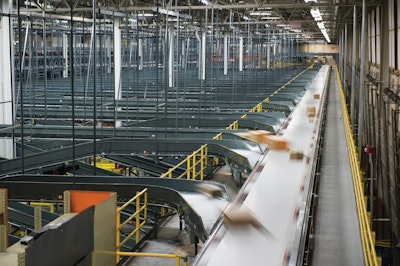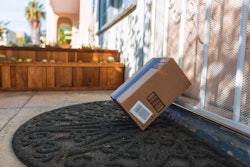
It’s no secret that most Americans are increasingly shopping online. For example, according to the U.S. Census Bureau’s most recent statistics, e-commerce sales in the fourth quarter of 2019 totaled $158 billion, a 16.7% increase as compared to Q4 2018. In fact, 89% of Americans make purchases online, with one in three doing so every week, according to a Fortune poll.
What’s more is, the Coronavirus disease (COVID-19) has changed Americans’ online shopping habits even further – U.S. online sales of consumer packaged goods grew 56% for the one week ending April 18, compared to the same period a year earlier, according to data from Nielsen and Rakuten Intelligence. This translates to high growth rates in e-commerce sales.
Simultaneously, competition for consumers’ online dollars continues to intensify, especially as Amazon, Target and Walmart remain locked in a three-way battle to win customers through same-day delivery services. Therefore, all distribution operations must be able to deliver in order to keep up.
Forbes reported that 75% of shoppers expect all brands to offer same-day delivery within the next 12 months. Translation? Having a robust e-commerce supply chain, especially in light of COVID-19, with the ability to support expanding and diverse inventory, error-free fulfillment and fast, free delivery options is no longer optional in the e-commerce world. It’s table stakes. The supply chain is a crucial pillar of e-commerce and essential for its success, growth and customer retention.
Now is the time for e-commerce retailers to sort out their plans for handling this dual challenge of online sales growth and meeting customer expectations for fast, accurate delivery. To remain competitive, operations must find ways to handle as many individual orders as possible, simultaneously. Fortunately, this is exactly why automated sortation solutions are a vital part of the e-commerce supply chain.
Automated sortation solutions consolidate, separate and route individual items and orders to their unique destinations at maximum throughput rates — and the market offers plenty of choices. Although all these systems merge, identify, induct, divert and convey products to specific destinations, finding the best-fit automated sortation solution to deliver the accuracy, efficiency and flexibility necessary to remain competitive requires a thorough review of operational requirements and the automated sortation system options available.
The evaluation process should include three key steps:
1. Gather key information about the order
To help determine the optimal solution, facility management must know the following benchmarks:
· Total number of orders handled per day.
· Ratio of multi- to single-line orders.
· Outbound packaging types used and their degree of dimensional consistency (or inconsistency).
While the first two points are important, the wider adoption of smaller, more malleable packaging types (such as envelopes, polybags and bubble mailers) for direct-to-consumer shipments is often the most critical factor in system selection. Implemented in response to the introduction of widespread dimensional weight pricing by carriers, these lighterweight packages cost less to ship, but create additional catch points that increase the chances of sortation conveyor jams or sortation loop recirculation.
Their use varies by operation, but modern fulfillment centers should consider the degree to which they currently (or will increasingly) handle a mix of malleable polybags, rigid corrugated cases and flexible bubble mailers. This means deploying a sortation system capable of reliably handling the unique challenges of all packaging types.
2. Determine the intended outcome of the sort
Certain sortation processes facilitate more effective order consolidation. This common order fulfillment process drives greater picking efficiency — yet requires a system with a large number of sort destinations in a limited space. This plays to the strengths of loop sortation technology in which individual load carriers receive items from multiple input points. The items continuously recirculate while awaiting other picks required by the same order to arrive prior to pack-out. Depending on the deployed technology, load discharge occurs in a variety of ways:
· A bomb bay sorter has carriers with two surface halves that drop open from below.
· Tilt-trays tip to one side or the other.
· Push-trays are equipped with a mechanism that pushes the load off the surface.
· Cross-belt carriers have a short section of motorized belt conveyor oriented perpendicularly to the sorter’s travel direction that propels the item off to the side.
The other common sortation application is the routing of order packages to different shipping trailers based on service level agreements or carrier arrangements. This type of workflow transports orders from pack-out to shipping, then diverts the items to different destinations at the outbound dock. To efficiently accommodate a high number of destination locations, outbound sortation usually uses line sorters that travel in a straight line with a single induction point.
As directed by an automatic identification technology — such as a barcode scanner or imager — items are pushed, diverted or deflected off the sorter’s path at appropriate points by means of a mechanical arm or other in-line device. Common line sorter technologies include sliding shoe (in which a series of divert shoes slide diagonally across a surface of continuously linked slats to contact the parcel and push it gently off the main conveyor line), motor-driven roller transfers and diverts, strip belt transfer, pop-up wheel belt, pop-up wheel strip belt or sweeper sorters.
3. Establish the desired throughput rate
With high e-commerce order volumes putting stress on the capacity of existing systems, knowing an operation’s throughput rates at both standard and peak periods is integral when selecting the most optimal automated sortation technology. Throughput rates can fuel return on investment calculations, as well as provide room for operations to scale for the future — an important factor in maximizing long-term value.
Do not, however, equate throughput to speed; rate of travel alone means nothing without proper product gapping, gentle handling and accuracy. Ensuring that the system can accommodate appropriate spacing between parcels to facilitate data capture during transport and handling (so that items can be sorted to the correct destinations) is key. Recent innovations in these types of sortation functions enable higher throughput without a corresponding increase in equipment speed, which ultimately reduces wear, energy usage and noise for a better long-term investment. Of course, as with most equipment purchases, the more complex the technology, the greater the cost.
Strategies to get sortation systems online quickly
Getting an automated sortation system up and running fast depends on a variety of factors, some of which can be controlled by the end user and some of which cannot. These include:
· Sortation vendor pipeline. Leading systems suppliers typically have a deeper manufacturing and engineering bench for capacity fluctuations.
· System complexity. Custom engineering and integration take time, so less customization means faster deployment schedules.
· Vendor consolidation. Working with a single-source provider (instead of multiple outside consultants and equipment vendors) offers significant speed advantages.
Complex challenges require an experienced perspective
Today’s e-commerce driven supply chains have little margin (or time) for error. In a distribution center, the relentless pace of order fulfillment and intense competitive pressures force operations to squeeze out as much sortation capacity as possible. Selecting a best-fit sortation solution requires considering the unique characteristics of both the operation and available technologies. To ensure the successful design and implementation of an innovative sortation package that meets your specific operational goals, partner with an experienced provider who has access to — and experience with — integrating a full lineup of sortation technologies.



![Pros To Know 2026 [color]](https://img.sdcexec.com/mindful/acbm/workspaces/default/uploads/2025/08/prostoknow-2026-color.mduFvhpgMk.png?auto=format%2Ccompress&bg=fff&fill-color=fff&fit=fill&h=100&q=70&w=100)







![Pros To Know 2026 [color]](https://img.sdcexec.com/mindful/acbm/workspaces/default/uploads/2025/08/prostoknow-2026-color.mduFvhpgMk.png?ar=16%3A9&auto=format%2Ccompress&bg=fff&fill-color=fff&fit=fill&h=135&q=70&w=240)







